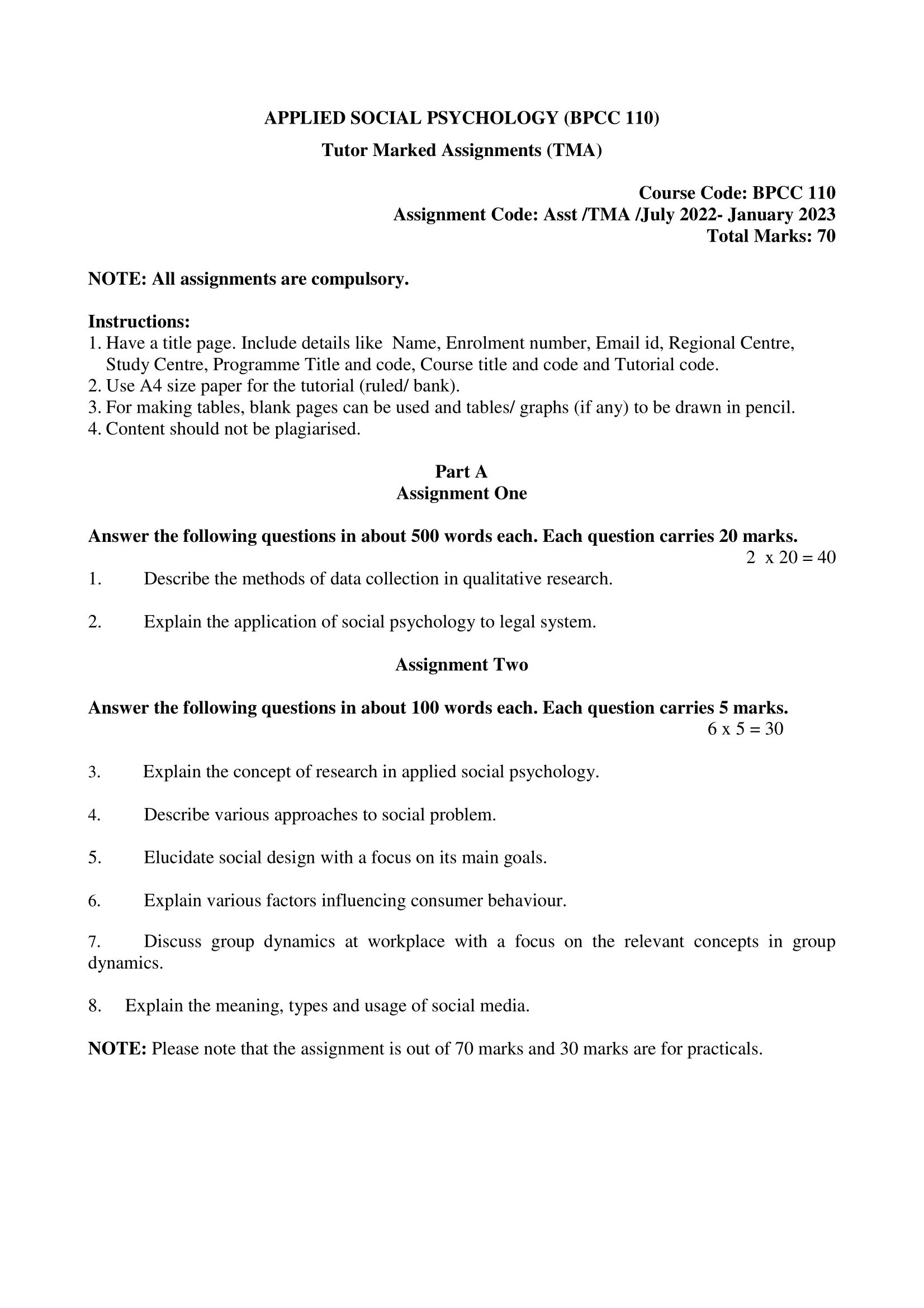Contents
- 1 Assignment One
- 2 Answer the following questions in about 500 words each. Each question carries 20 marks.
- 3 1. Describe the methods of data collection in qualitative research.
- 4 2. Explain the application of social psychology to legal system.
- 5 Assignment Two
- 6 Answer the following questions in about 100 words each. Each question carries 5 marks.
- 7 3. Explain the concept of research in applied social psychology.
- 8 4. Describe various approaches to social problem.
- 9 5. Elucidate social design with a focus on its main goals.
- 10 6. Explain various factors influencing consumer behaviour.
- 11 7. Discuss group dynamics at workplace with a focus on the relevant concepts in groupdynamics.
- 12 8. Explain the meaning, types and usage of social media.

| Title | BPCC-110: IGNOU BAG Solved Assignment 2022-2023 |
| University | IGNOU |
| Degree | Bachelor Degree Programme |
| Course Code | BPCC-110 |
| Course Name | APPLIED SOCIAL PSYCHOLOGY |
| Programme Name | Bachelor of Arts (General) |
| Programme Code | BAG |
| Total Marks | 100 |
| Year | 2022-2023 |
| Language | English |
| Assignment Code | Asst /TMA /July 2022- January 2023 |
| Last Date for Submission of Assignment: | For June Examination: 31st April For December Examination: 30th September |

Assignment One
Answer the following questions in about 500 words each. Each question carries 20 marks.
1. Describe the methods of data collection in qualitative research.
Ans: Qualitative research is a type of research that focuses on exploring and understanding people’s experiences, beliefs, and attitudes through open-ended data collection methods. It is a highly subjective approach that emphasizes the richness and complexity of human behavior, which is difficult to capture using quantitative methods. Qualitative research data collection methods are diverse, flexible, and context-dependent. In this article, I will describe some of the most common methods of data collection used in qualitative research.
1.1 Interviews Interviews are one of the most commonly used methods of data collection in qualitative research. They involve a one-on-one conversation between the researcher and the participant, during which the participant shares their experiences, opinions, and perceptions on a particular topic. Interviews can be structured, semi-structured, or unstructured, depending on the research question and the level of guidance required. Structured interviews involve a pre-determined set of questions, while semi-structured and unstructured interviews provide more freedom for the participant to express their thoughts and feelings.
1.2 Focus groups Focus groups are another common method of data collection in qualitative research. They involve a group of participants who discuss a particular topic under the guidance of a facilitator. The facilitator usually asks open-ended questions and encourages participants to share their thoughts and experiences with each other. Focus groups are useful for exploring group dynamics, social norms, and shared experiences.
1.3 Observation Observation is a method of data collection that involves watching and recording people’s behavior in their natural setting. It can be structured or unstructured, and it can be done in person or through video recordings. Observation is useful for understanding social interactions, cultural practices, and environmental influences on behavior.
1.4 Document analysis Document analysis is a method of data collection that involves analyzing written or visual materials related to the research topic. It can include texts, photographs, videos, social media posts, and other forms of media. Document analysis is useful for exploring historical or cultural contexts, as well as examining how people construct and communicate their experiences.
1.5 Case studies Case studies are a method of data collection that involves in-depth exploration of a particular case or phenomenon. The case can be an individual, a group, an organization, or a community. Case studies involve multiple sources of data, including interviews, observation, and document analysis. Case studies are useful for exploring complex or unique situations, and they provide rich and detailed data.
Ans: Social psychology is the scientific study of how people think, feel, and behave in social situations. It explores the social factors that influence human behavior and decision-making, including attitudes, group dynamics, persuasion, and social norms. The application of social psychology to the legal system is an emerging field that seeks to better understand the social and psychological factors that influence legal decision-making and behavior.
The legal system is a complex social institution that involves many different actors, including judges, lawyers, jurors, witnesses, and defendants. Social psychology can help us understand how these actors make decisions and interact with each other, as well as how social factors such as stereotypes, biases, and emotions can affect legal outcomes. Here are some of the ways that social psychology can be applied to the legal system:
- Jury decision-making Jury decision-making is a crucial part of the legal system, and it is influenced by many social and psychological factors. Social psychology can help us understand how jurors make decisions, how group dynamics influence their deliberations, and how preconceptions and biases affect their judgments. For example, research has shown that jurors can be influenced by factors such as the defendant’s race, gender, and attractiveness, as well as by the emotions and attitudes of other jurors.
- Eyewitness testimony Eyewitness testimony is often used in criminal trials, but it is subject to many biases and errors. Social psychology can help us understand how factors such as the passage of time, leading questions, and the presence of a weapon can influence the accuracy and reliability of eyewitness testimony. Social psychologists have also developed techniques for improving eyewitness identification, such as the use of sequential lineups and minimization of suggestive language.
- Legal decision-making Judges and lawyers make decisions that affect the lives of many people, and these decisions can be influenced by social and psychological factors. Social psychology can help us understand how judges and lawyers make decisions, how they perceive and interpret evidence, and how they are influenced by factors such as emotions, stereotypes, and biases. For example, research has shown that judges can be influenced by factors such as the order in which evidence is presented, the defendant’s demeanor, and the severity of the crime.
- Police practices and procedures Police practices and procedures can have a significant impact on the outcomes of criminal investigations and trials. Social psychology can help us understand how factors such as police interrogation techniques, racial profiling, and use of force can influence outcomes. Research has shown that interrogation techniques such as the Reid Technique can produce false confessions, while racial profiling can lead to biased policing practices.
Assignment Two
Answer the following questions in about 100 words each. Each question carries 5 marks.
Ans: Research in applied social psychology refers to the systematic investigation of real-world issues and problems through the use of social psychological theories, principles, and methods. The goal of applied social psychology research is to contribute to the development of practical solutions that can improve the lives of individuals and communities.
The research process in applied social psychology typically involves several steps, including problem identification, hypothesis formulation, data collection, analysis, and interpretation. Researchers in this field use a wide range of research methods, such as surveys, experiments, observations, and interviews.
Applied social psychology research can be applied in various areas, such as education, health, environment, law, and business. For example, researchers may study the factors that contribute to prejudice and discrimination in the workplace or develop and evaluate interventions to reduce the incidence of risky health behaviors.
Ans: Social problems refer to issues or situations that affect individuals, groups, or society as a whole and may be challenging to solve. Several approaches have been proposed to address social problems, including:
- Individual-focused approaches: These approaches aim to address social problems by targeting individual behavior and characteristics. They typically involve providing education, training, counseling, or other services to individuals. Examples include drug treatment programs, mental health services, and financial assistance programs.
- Structural or systems-focused approaches: These approaches aim to address social problems by addressing the underlying social, economic, and political structures that contribute to them. They typically involve policy changes or social action aimed at changing laws, regulations, or institutions. Examples include policies aimed at reducing income inequality, improving access to healthcare, or increasing educational opportunities.
- Community-based approaches: These approaches aim to address social problems by engaging with communities and empowering them to address their own problems. They typically involve community organizing, collective action, and capacity building. Examples include community-led initiatives to address crime, poverty, or environmental issues.
- Advocacy and activism: These approaches aim to address social problems by raising awareness, mobilizing public opinion, and pressuring institutions to take action. They typically involve lobbying, protests, media campaigns, and other forms of activism. Examples include movements for social justice, environmental protection, and civil rights.
In practice, these approaches are often combined to address social problems in a comprehensive and integrated way. For example, an effective strategy to address poverty might involve providing job training and financial assistance to individuals, while also advocating for policies that reduce income inequality and promoting community-led initiatives to address the root causes of poverty.
Ans: Social design refers to the application of design thinking and practices to address social issues and improve the quality of life for individuals and communities. The primary goal of social design is to create innovative solutions that are sustainable, effective, and equitable.
Some of the main goals of social design include:
- Identifying and addressing social problems: Social design aims to identify and understand social problems, such as poverty, inequality, and environmental degradation, and develop innovative solutions to address them.
- Promoting social equity and inclusion: Social design aims to create solutions that promote social equity and inclusion, particularly for marginalized or disadvantaged communities.
- Empowering communities: Social design aims to empower communities to take an active role in shaping and implementing solutions to social problems.
- Fostering collaboration: Social design aims to foster collaboration among stakeholders, including designers, community members, policymakers, and other organizations, to create more effective and sustainable solutions.
- Creating sustainable solutions: Social design aims to create solutions that are environmentally and economically sustainable, to ensure that they can be maintained and scaled over time.
- Applying human-centered design principles: Social design aims to apply human-centered design principles, such as empathy, co-creation, and iteration, to develop solutions that meet the needs and preferences of the individuals and communities they serve.
6. Explain various factors influencing consumer behaviour.
Ans: Consumer behavior refers to the actions and decisions that individuals make when purchasing and using products or services. Several factors can influence consumer behavior, including:
- Personal factors: Personal factors such as age, gender, income, education, lifestyle, and personality can influence consumer behavior. For example, a consumer’s age and income level may affect their purchasing power, while their lifestyle and personality may affect their preferences for certain products or brands.
- Social factors: Social factors such as family, friends, culture, and social class can influence consumer behavior. For example, a consumer’s cultural background may affect their preferences for certain types of food or clothing, while their social class may influence their purchasing decisions for luxury goods or experiences.
- Psychological factors: Psychological factors such as motivation, perception, learning, beliefs, and attitudes can influence consumer behavior. For example, a consumer’s motivation to purchase a product may be influenced by their need for the product or their desire for status or prestige associated with the product.
- Marketing factors: Marketing factors such as advertising, pricing, product design, and distribution can influence consumer behavior. For example, advertising can influence consumer perceptions and attitudes towards a product or brand, while pricing strategies such as discounts or promotions can affect consumer purchase decisions.
- Situational factors: Situational factors such as time, place, and context can influence consumer behavior. For example, a consumer’s purchase decision may be influenced by the time of day, the location of the store, or their mood or emotional state.
7. Discuss group dynamics at workplace with a focus on the relevant concepts in group
dynamics.
Ans: Group dynamics refers to the interactions, relationships, and processes that occur within a group of individuals. In the workplace, group dynamics can influence team performance, job satisfaction, and overall organizational effectiveness. Several key concepts are relevant to understanding group dynamics in the workplace, including:
- Group cohesion: Group cohesion refers to the level of attraction and commitment among group members. Cohesive groups tend to be more productive, satisfied, and effective than less cohesive groups, as members are more likely to work together and support each other.
- Social loafing: Social loafing occurs when individuals in a group exert less effort than they would if they were working alone. This can be due to a lack of accountability or motivation, and can lead to reduced team performance and productivity.
- Group norms: Group norms refer to the unwritten rules and expectations that govern behavior within a group. Norms can influence individual behavior and attitudes, and can affect team performance and job satisfaction.
- Groupthink: Groupthink occurs when group members prioritize agreement and harmony over critical thinking and individual dissent. This can lead to poor decision-making and can be a barrier to innovation and creativity within a team.
- Diversity: Diversity within a group can refer to differences in demographic characteristics, such as age, gender, and ethnicity, as well as differences in skills, knowledge, and experience. Diversity can enhance group performance by bringing new perspectives and ideas to the team, but can also lead to conflicts or challenges if not managed effectively.
To promote positive group dynamics in the workplace, it is important for organizations to develop effective communication, establish clear goals and expectations, encourage collaboration and feedback, and recognize and value diversity within teams. Team-building activities and training programs can also be useful in promoting cohesion and addressing potential issues such as social loafing or groupthink. Overall, understanding and managing group dynamics can help organizations to foster a positive and productive work environment.
Ans: Social media refers to online platforms and tools that allow people to share, create, or exchange information, ideas, and content. Social media platforms have become increasingly popular and have transformed the way people communicate and interact with each other. There are various types of social media, including social networking sites, microblogging sites, media sharing sites, and messaging apps. Social media is used for various purposes, including socializing, networking, entertainment, and marketing. Social media provides individuals and organizations with a means to reach a global audience and to build online communities. Social media has also enabled the spread of information and the promotion of social causes.
How to Download BPCC-110 Solved Assignment?
You can download it from the www.edukar.in, they have a big database for all the IGNOU solved assignments.
Is the BPCC-110 Solved Assignment Free?
Yes this is absolutely free to download the solved assignment from www.edukar.in
What is the last submission date for BPCC-110 Solved Assignment?
For June Examination: 31st April, For December Examination: 30th October













![[Solved Assignment] BPCS 188-APPLICATIONS OF SOCIAL PSYCHOLOGY (IGNOU-BAG) 2022-2023 BPCS 188-APPLICATIONS OF SOCIAL PSYCHOLOGY IGNOU BAG Solved Assignment 2022-2023](https://edukar.in/wp-content/uploads/2023/01/BPCS-188-APPLICATIONS-OF-SOCIAL-PSYCHOLOGY-IGNOU-BAG-Solved-Assignment-2022-2023-1024x640.webp)


